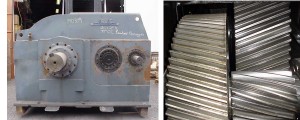 Vibration is present in nearly every aspect of life, and understanding how vibrations work can often improve performance. Yoginis and New Age types aren’t the only ones to value and “tune into” vibrations. For instance, a guitarist has to understand how to tune his instrument so it vibrates in the same key as the instruments of his band mates. A less obvious application of vibration analysis appears in ground transportation: Automobile and bus designers have found that they can improve passengers’ comfort by monitoring and adjusting low-frequency vibrations in seating. In many instances, vibration is desirable, even necessary. However, when dealing with mechanical components such as a Falk gear reducer, vibration is unwelcome, since it typically represents inefficiency.
Vibration is present in nearly every aspect of life, and understanding how vibrations work can often improve performance. Yoginis and New Age types aren’t the only ones to value and “tune into” vibrations. For instance, a guitarist has to understand how to tune his instrument so it vibrates in the same key as the instruments of his band mates. A less obvious application of vibration analysis appears in ground transportation: Automobile and bus designers have found that they can improve passengers’ comfort by monitoring and adjusting low-frequency vibrations in seating. In many instances, vibration is desirable, even necessary. However, when dealing with mechanical components such as a Falk gear reducer, vibration is unwelcome, since it typically represents inefficiency.
Specifically, mechanical vibrations often indicate imbalance between rotating parts. For instance, as the teeth in a surplus gear reducer come together, they will inevitably create vibration as they rub against each other. Mechanics know it’s impossible to completely eliminate such vibrations, but they also recognize that a change in vibration patterns often precedes a failure. That’s because most mechanical parts tend to vibrate more, or in unique patterns, as they near the end of their lives. Therefore, a shift in mechanical vibrations may indicate that gearbox repairs may soon be required. Indeed, by watching vibration tendencies, technicians can replace worn out parts before they cause total failure.
What is Vibration Analysis?
Vibration analysis involves monitoring the vibrations emitted by a surplus gear reducer or any other mechanical component. It is one type of condition monitoring. Typically, engineers and mechanics aim to measure vibration frequencies when a Falk gear reducer or other gearbox is running at its full capacity. Each type of gear vibrates at its own range of frequencies. In addition to gear type, vibration patterns are influenced by operation speed, equipment load and criticality.
How Vibration Analysis Works
In vibration analysis, a sensor is attached to each Falk gear reducer or other machine. Some people use stringers to attach sensors to machine bearing casings, but this is unfavorable, since stringers can only measure a limited range of frequencies. Stringers also make it difficult to attach the sensor to the machine with the same amount of pressure each time you hope to take a measurement. Some designers have overcome this difficulty by creating sensors that don’t require physical contact; for instance, they may use microphones or lasers to establish vibration patterns.
Magnets, screws or permanent fixtures may also be used to mount sensors, but engineers must consider that different mounting techniques provide different frequency measurements. (For this reason, most sensor manufacturers include calibration directions.) Basically, the sensor converts vibration data into electrical impulses, which a data collector gathers and translates into data that can actually be used. Engineers may review graphs portraying any number of variables related to vibration.
Why Vibration Analysis is Important for Drive Maintenance
All forms of condition monitoring, including vibration analysis, aspire toward predictive maintenance. The earlier engineers and mechanics can discover changes in vibration frequencies, the sooner they can replace worn out parts and the more money that may be saved in the form of costly gearbox repairs. Specifically, vibration analysis allows management to set alarms to indicate when each machine requires attention.
Vibration Analysis Tips
How long to keep vibration data. Vibration data is typically recorded and stored so engineers may analyze performance data as they wish. Oftentimes, vibration data loses historical value after a couple of years. As machines and components are changed out, vibration frequencies change, making older data moot. On the other hand, some firms may choose to maintain vibration data for long-running machines, as this information can have analytical value. Each company will need to set its own standards for data maintenance. Once you have a plan, double check your data center emergency preparedness. For instance, you should have a regularly scheduled backup of your most important hard drives.
Setting amplitude levels on a machine-by-machine basis. Professionals often look at overall amplitude levels to indicate when a gearbox may be misaligned or ready to break. However, it’s unwise to set generic amplitude levels for different machines. Indeed, it’s impossible. Every Falk gear reducer will have its own unique factors impacting vibration.
By tracking the vibration patterns of Falk gear reducers and other mechanical components, you can better anticipate and prevent problems.
Posted under Articles, Machinery Maintenance on Friday, November 18th, 2011
